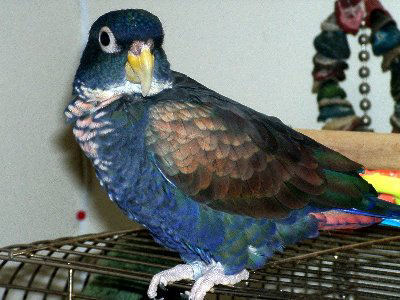Piones - Bronze Wing
Bronze Winged Parrot Scientific Name: Pionus chalcopterus chalcopterus
Thu, 9th January, 2025 - 3:27 pm GMT
Sponsor Ads:

Alternative Name
Bronze Winged Parrot Scientific Name: Pionus chalcopterus chalcopterusBasic Info
Bronze Wing's beautiful colors increase as they mature. Often described as "muddy," babies lack the striking coloration of the adults. A mature Bronze Winged Pionus has violet blue feathers that are etched with dark grey. Its wings are flecked with bronze. They have muted pink feathers on their throats, and they have white chins. Throughout their plumage varying shades of green, blue, chestnut, and purple are seen. Like other Pionus species, the underside of their tail is red. In bright natural light their plumage appears iridescent and will often give the appearance of changing as they move. They have yellowish colored beaks and flesh colored feet. The Bronze Winged Pionus is a medium sized parrot measuring 11.5 inches (29 centimeters). Females are more predominant in the species. And they are somewhat sexually dimorphic, in that females will tend to get a pinkish color on the skin around the eye (eye ring) when in breeding season and hormonal.
Health
The Bronze Winged Pionus may be susceptible to fungal infections. If males and females are kept together, they should be watched, because male Bronze Winged Pionus tend to pluck the females. This is usually most evident on the heads of the females. Breeding The Bronze Winged Pionus is bred regularly in captivity. Breeding season will usually begin in the spring, sometime in April. After breeding the female will lay an average of 4 to 5 eggs. The eggs will incubate for a period of 26 days. Babies will fledge after 2 months. They may take longer to wean in captivity than some of the other Pionus species.Habitat
They tend to favor tropical and sub-tropical forests and are also seen in deforested areas as well.Behavior
The Bronze Wing Pionus is called a "Living Rainbow" by some aviculturists, and it is perhaps the most beautiful of all the different Pionus species. They also tend to be the shyest of the the Pionus family. The Bronze Wing Pionus is not as popular in the pet trade as the Blue Head or the Maximillian, but its popularity is growing steadily, and they are becoming increasingly available in the pet market. The Bronze Winged Pionus is known for its good-natured personality. Though they are not avid chewers like some parrots, they should be given plenty of chew toys. They are much quieter than other parrots, but they may become quite loud from time to time, and some may also learn to screech. Like other Pionus they may be rather shy, but they will become tame with regular handling. In the wild, the Bronze Wing Pionus is usually seen in small groups or pairs. They may be noisy when flying. Like other Pionus species, the Bronze Wing will often make a wheezing sound when they are frightened. This may be quite disconcerting to those who have not spent much time with a Pionus.Origin
South AmericaHistory
They are native to South America and are found in Venezuela and Columbia. They tend to favor tropical and sub-tropical forests and are also seen in deforested areas as well.Common Foods
In the wild they feed on berries, fruits, flowers, and seeds. In captivity they do well on a varied diet that should include plenty of fresh fruits and vegetables.Sponsor Ads:
Pessimism is self-fulfilling.
Piones - Bronze Wing
Coded by: BGID® | ALL RIGHTS RESERVED Copyright © 2000-2025
Disclaimer | Privacy | Report Errors / Contact | Credits








 President of the United States of America - Real Estate mogul, Pageant owner and now one of the most controversial men in political history.
President of the United States of America - Real Estate mogul, Pageant owner and now one of the most controversial men in political history.  Politician, US Vice President and President of the USA - Joseph Robinette Biden Jr.
Politician, US Vice President and President of the USA - Joseph Robinette Biden Jr.  versus
versus  Russia: 'The Evil Empire'? Are they all that bad or is it just the USA trying to portray Russia as bad because they are a world power with land bigger and a society very different from the USA ideal?
Russia: 'The Evil Empire'? Are they all that bad or is it just the USA trying to portray Russia as bad because they are a world power with land bigger and a society very different from the USA ideal?  Global warming has been in and out as the "latest" hot topic for many years. It is, according to modern scientists, the result of man-made industrial pollutants, clearing forested areas, agriculture, etc. But now they are thinking it started way before the Industrial Revolution...
Global warming has been in and out as the "latest" hot topic for many years. It is, according to modern scientists, the result of man-made industrial pollutants, clearing forested areas, agriculture, etc. But now they are thinking it started way before the Industrial Revolution... 
 Corona virus
Corona virus 
 Users with wide screen monitors can benefit from more content on every page.
Users with wide screen monitors can benefit from more content on every page.